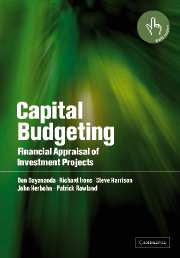Book contents
- Frontmatter
- Contents
- List of figures
- List of tables
- Preface
- 1 Capital budgeting: an overview
- 2 Project cash flows
- 3 Forecasting cash flows: quantitative techniques and routes
- 4 Forecasting cash flows: qualitative or judgemental techniques
- 5 Essential formulae in project appraisal
- 6 Project analysis under certainty
- 7 Project analysis under risk
- 8 Sensitivity and break-even analysis
- 9 Simulation concepts and methods
- 10 Case study in financial modelling and simulation of a forestry investment
- 11 Resource constraints and linear programming
- 12 More advanced linear programming concepts and methods
- 13 Financial modelling case study in forestry project evaluation
- 14 Property investment analysis
- 15 Forecasting and analysing risks in property investments
- 16 Multinational corporations and international project appraisal
- References
- Index
10 - Case study in financial modelling and simulation of a forestry investment
Published online by Cambridge University Press: 14 May 2010
- Frontmatter
- Contents
- List of figures
- List of tables
- Preface
- 1 Capital budgeting: an overview
- 2 Project cash flows
- 3 Forecasting cash flows: quantitative techniques and routes
- 4 Forecasting cash flows: qualitative or judgemental techniques
- 5 Essential formulae in project appraisal
- 6 Project analysis under certainty
- 7 Project analysis under risk
- 8 Sensitivity and break-even analysis
- 9 Simulation concepts and methods
- 10 Case study in financial modelling and simulation of a forestry investment
- 11 Resource constraints and linear programming
- 12 More advanced linear programming concepts and methods
- 13 Financial modelling case study in forestry project evaluation
- 14 Property investment analysis
- 15 Forecasting and analysing risks in property investments
- 16 Multinational corporations and international project appraisal
- References
- Index
Summary
Forestry projects are a form of capital investment with a particularly long time horizon, and as such present an interesting case of capital budgeting. In many countries, plantation forestry has traditionally been the domain of government agencies, e.g. the national Forestry Commission in the UK and the various state forestry services in Australia. Timber was considered to be a critical economic resource but the long production period meant that only governments had the long-term perspective and capacity to enter into forestry investments. This situation has changed markedly in the past fifty years, with probably the bulk of forestry investment in most countries being undertaken by private companies and individuals. The need for the establishment of plantations has been stimulated by decreasing supplies of timber from native forests through unsustainable logging practices, and the withdrawal of large areas from logging because of their being set aside as protected areas, particularly in tropical counties.
An integral component of investment in forestry is the need for financial information about the likely cash flows associated with the establishment, management and final harvest of a plantation. This chapter uses the development of a financial model for forestry investment as a case study of financial modelling. The financial evaluation of forestry projects poses many challenges and this chapter examines the key parameters for forestry appraisal and some of the problems faced by developers of financial models.
- Type
- Chapter
- Information
- Capital BudgetingFinancial Appraisal of Investment Projects, pp. 185 - 203Publisher: Cambridge University PressPrint publication year: 2002



